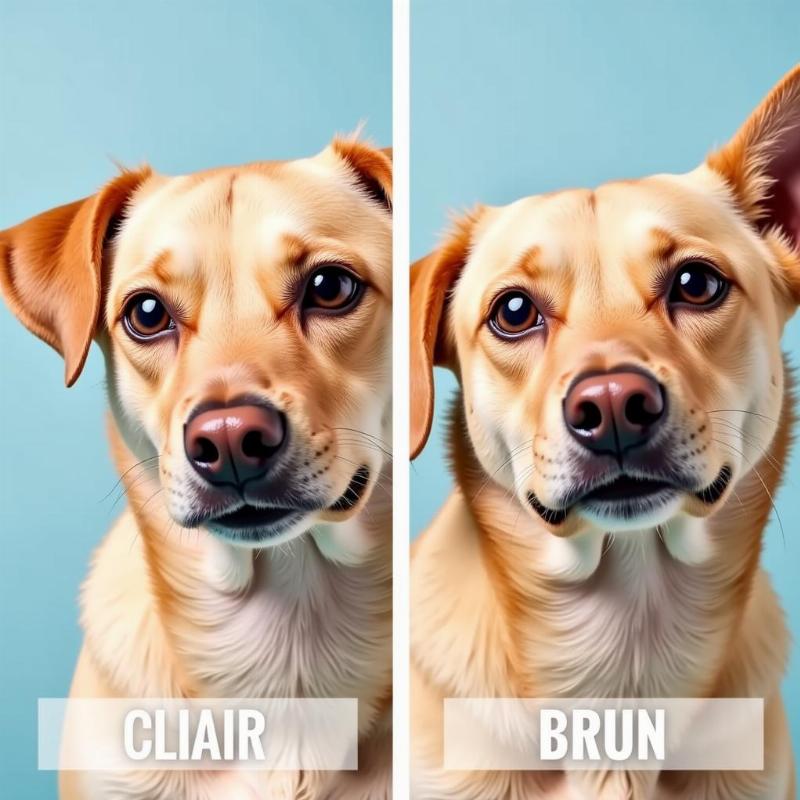Tear stains, those reddish-brown streaks beneath your dog’s eyes, can be a frustrating aesthetic issue for pet owners. While often harmless, they can sometimes signal an underlying health concern. Understanding the causes of tear stains and how tear stain wipes for dogs can help manage them is essential for maintaining your furry friend’s eye health and that picture-perfect look.
Understanding the Causes of Tear Stains
Several factors can contribute to tear staining in dogs. Certain breeds, like Maltese, Poodles, and Shih Tzus, are genetically predisposed to excessive tearing. Allergies, whether environmental or food-related, can also trigger increased tear production. Other causes include blocked tear ducts, infections, ingrown eyelashes, and even the shape of your dog’s face and eye sockets.
 No More Worrying About Dog Tear Stains
No More Worrying About Dog Tear Stains
Choosing the Right Tear Stain Wipes for Your Dog
The market offers a variety of tear stain wipes, each formulated with different ingredients. Look for gentle, pH-balanced wipes that are specifically designed for the sensitive skin around the eyes. Avoid wipes containing harsh chemicals, bleach, or alcohol, as these can irritate your dog’s eyes. Opt for wipes with natural ingredients like chamomile, aloe vera, or boric acid, known for their soothing and cleansing properties.
How to Use Tear Stain Wipes Effectively
Using tear stain wipes correctly is crucial for optimal results. Gently wipe the area around your dog’s eyes, avoiding direct contact with the eyeball. Use a fresh wipe for each eye to prevent cross-contamination. For stubborn stains, hold the wipe against the stain for a few seconds to loosen the debris. Regular use, ideally daily, is key to preventing stain buildup.
Tips for Preventing Tear Stains
Beyond using tear stain wipes, several proactive measures can help prevent tear stains from developing. Regular grooming, including trimming the hair around the eyes, can reduce moisture buildup. Providing fresh, filtered water can minimize mineral deposits that contribute to staining. If you suspect allergies are the culprit, consult your veterinarian to identify and address the allergen.
Addressing Underlying Health Issues
While tear stain wipes can manage the appearance of tear stains, it’s important to address any underlying health issues contributing to the problem. If you notice excessive tearing, redness, swelling, or any other signs of eye irritation, consult your veterinarian. They can diagnose the cause and recommend appropriate treatment, which may include antibiotics, eye drops, or surgery for blocked tear ducts.
When to Consult a Veterinarian
Are you noticing a sudden increase in tearing, redness around the eyes, or discomfort in your dog? These could be signs of an underlying issue requiring veterinary attention. Don’t hesitate to reach out to your vet if you’re concerned about your dog’s eye health.
Conclusion
Tear stain wipes for dogs can be an effective tool for managing tear stains and keeping your dog’s eyes looking bright and healthy. By choosing the right wipes, using them correctly, and addressing any underlying health concerns, you can help your furry friend maintain their beautiful, sparkling eyes. Remember, regular vet checkups are vital for ensuring overall health and addressing any potential issues promptly.
FAQ
-
Are tear stain wipes safe for all dog breeds? While most tear stain wipes are formulated for general use, it’s always best to choose wipes specifically designed for the sensitive skin around the eyes. Consult your veterinarian if you have any concerns about a specific product.
-
How often should I use tear stain wipes on my dog? Daily use is generally recommended for preventing stain buildup. However, you can adjust the frequency based on your dog’s individual needs.
-
Can tear stains be a sign of a serious health problem? While often harmless, excessive tearing can indicate an underlying health issue. If you notice any other symptoms, such as redness, swelling, or discharge, consult your veterinarian.
-
What should I do if my dog’s tear stains don’t improve with wipes? If tear stains persist despite regular wiping, it’s important to consult your veterinarian to rule out any underlying medical conditions.
-
Can diet affect tear staining? Yes, certain foods can contribute to tear staining in some dogs. Discuss dietary changes with your veterinarian if you suspect food allergies are playing a role.
-
Are there any home remedies for tear stains? While some home remedies exist, it’s crucial to consult your veterinarian before trying any, as some can be harmful.
-
Can tear stains be permanent? While stubborn stains can be difficult to remove completely, consistent use of quality tear stain wipes and addressing any underlying causes can significantly improve their appearance.
Beautdogs.us is your premier destination for all things dog-related in the US. We provide expert advice on dog breeds, care, and product recommendations, serving as a trusted resource for both novice and experienced dog owners. We offer a range of services to ensure your furry friend receives the best possible care. Contact us today to learn more! Email: [email protected], Phone: +1 501-555-7529. Visit Beautdogs.us for more information and expert tips.